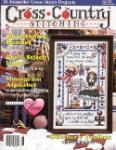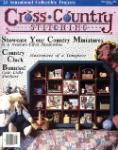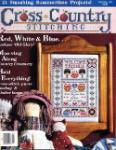/
Text
Cross Stitch Quilt • Fabulous Footstool • Country Casuals
Cover Story
ifiBCDE;
Stitch away a gray winter day with the with these plumed birds and dainty potted roses. A few specially placed satin stitches will complete this elegant country French sampler.
Sampler worked over two threads on 28 count Quaker cloth. Fabric courtesy of Joan Toggitt, Ltd. For frame and mat, see Buyer’s Guide on page 20.
Satin Stitch
Satin Stitch is formed by using 2 ply floss and stitching from point A to В with one long stitch. Then point C to D, E to F, etc. follow diagram.
What are you sporting on Saturday morning? Warmup and collect all of our fashionable country casuals. Are you a tag sale hunter - a country or antiques collector? With these beauties you’ll let eveyone know - and you’ll never be lost in the crowd.
Thermal sweatshirts are stitched using all six ply of floss. These are available from Designing Women, Unltd. Charts on pages 20, 21 & 28.
General Working Instructions
Placement of all designs should be checked by trying on vests or shirts. Adjust yoke designs for different size shifts and necklines. Use the recessed holes in the knit as the four corners of your cross stitch. We recommend all six strands of cotton floss cut in long pieces and a #20 tapestry needle. No separation into: individual strands is necessary. Outlines and other stitches use all six strands unless otherwise indicated. Begin and end threads by running tinder five or six stitches in back vertically and going back through in the opposite direction. To allow for Stretch, make stitches on the inside of shirt vertical whenever possible. Do not pull stitches too tightly. Single stitches should be tied securely with a square knot on the back. Do not use a hoop.
Washing Instructions
Use gentie, cold water detergent and cold water only. Soak, do not rub or wring.
Rinse well and roll in towel to remove excess water. Allow to dry flat, do not use
If Designing Women Unltd.® thermals are unvailable in your area,
ABCDEFGffiJi KLMHOPQRS | vtwwxyzm
<3or y/L iSfaJl yr yg* -i
Linda
Linda is a 27 count plainweave fabric. Stitching over two threads will give you a final design of approximately 13 1/2 squares per inch. We chose to use 3 ply floss on our model for even coverage.
Be sure, when stitching over 2 threads to cover both horizontal and vertical axes.
See illustration.
★ For extra helpful hints on plainweave stitching, see "Ask Judie” on page 30.
From Dorothy's
Kite Heii
Seasoned flour 1 cup flour 1 1/4 teaspoons salt 2 1/2 teaspoons celery salt 1 1/2 teaspoon pepper 1 tablespoon dry mustard 2 tablespoon paprika 1/2 teaspoon oregano 1/2 teaspoon basil 1/2 teaspoon thyme 1/2 teaspoon ginger 2 1/2 teaspoons garlic powder Mix together and store in tightly covered
2-2 1/2 lbs. stew beef, cubed 1 bay leaf
1/2 teaspoon marjoram 1 garlic clove, minced 1 pouch onion soup mix 6 cups water 5 potatoes, cubed 4 cups coarsely chopped onions 5 carrots, chunked
Shake meat in a plastic bag with seasoned flour. Brown in hot fat in Dutch Oven. Add onions, garlic, bay leaf, soup, water and marjoram. Simmer for 1 1/2 hours. Add carrots and potatoes and simmer another 40 minutes. Remove bay leaf and drop dumplings over simmering stew. Cover tightly and continue simmering without lifting cover for 15 minutes. Serves 6
Herb Dumplings 1 1/2 cups flour 1 tablespoon baking powder 1 1/2 tablespoon butter 1/2 teaspoon salt
3 teaspoon dried parsley flakes 1/4 teaspoon thyme 2/3 cup milk
in butter. Stir in parsley thyme and then
Ask Judic
Q. So many of the designs I like call for Davos, but when 1 stitch on Davos 1 keep los-
Can you give me some hints for working
samplers that call for some areas over 2 and some areas over 1, but I am nervous about beginning them.
A. Davos, like linen, is a plain-weave fabric, with individual threads simply woven over -under - over - under. (Unlike Aida, where the
Because Davos has 18 threads per inch we tend to work it “over 1”, but it is just larger than working 26-36 count linen “over 1”. The same techniques apply to both.
Always use a stab stitch - down in one motion, up with another - rather than a sewing motion (down and up in one motion).
When working a straight row of one color, then return by completing the cross stitches.
You must, however, maintain a soft, but not sloppy, tension.
Vhen moving around on the fabric and not oing straight rows, for instance when stit-hing letters, it may be wise to complete each .itch as you go. Again, a soft tension is ecessary. When immediately crossing a half-
tersection. This may require crossing the itch from top to bottom when you usually oss from bottom to top (or visa versa). This iay even be necessary on the end/turning .itch of a straight row of solid-color stitches.
Happy stitchin’!



